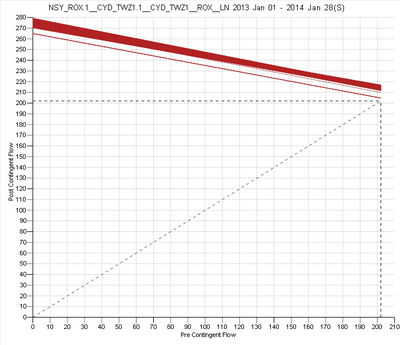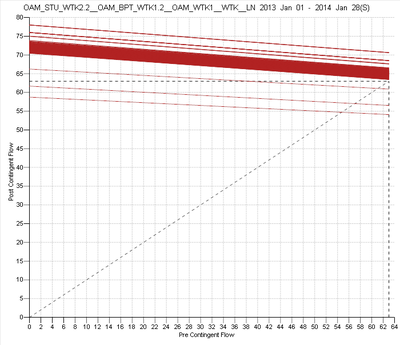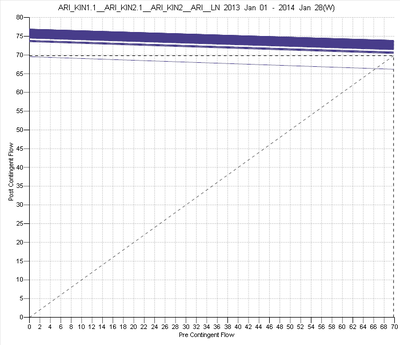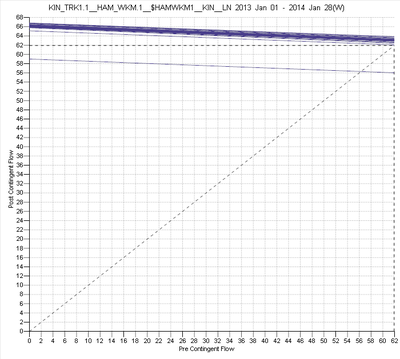EMO:Estimation From Historical Constraints
The power flows used in this relationship are from an AC power flow model, which is constructed using the SPD solution in conjunction with reactive power modelling and a detailed model of the transmission grid componentry. The full information for creating this AC model is not available to us, so there is an inevitable degree of approximation in estimating SFT constraints from our point of view. To model this constraint in EMO we also need to estimate the nature of the pre-post power flow constraint for each line. We do not currently have access to the definitions of these functions, but we are informed that they are quadratic functions and they will pass through the point \(( \underline{C}, \underline{C} )\) where \(\underline{C}\) is the thermal capacity of the line, which is a value we do have access to. Given that the constraint is a quadratic function and we know one point on the function there are two degrees of freedom left to estimate. Here we look at estimating \(\beta\), the slope of the curve at \(( \underline{C}, \underline{C} )\), and \(\alpha\), the rate of change in that slope with respect to \(F_{m}\).
The slope of the tangent of this curve at \(F_{m}\) is given explicitly in the resulting constraint equation in SPD, being negative the value A in Equation 1. We have the arc flows \(F_{m}\) from the SPD solution so, given enough instances of an SFT equation for a particular protected line, we might be able to estimate its pre-post constraint curve. We are informed that the thermal environment used for each curve is purely dependent on the Summer/Shoulder/Winter designation of the trading period so we can make a sample of all the constraints that fall into each category.
To estimate the curve then we can try to find the linear relationship between the slope and the pre-contingent flow. Given all equations associated with a particular combination of SFT constraint and thermal environment, we are looking for values of \(\alpha\) and \(\beta\) which have the following relationships. If a good fit for these values can be found the quadratic curve can be estimated.
| Equation 2. | \[A \simeq \alpha \big(\underline{C} - \underline{F}_{m} \big)+\beta\] |
| Equation 3. | \[C \simeq \underline{C} + \frac{ \alpha }{2} \big(\underline{C} - \underline{F}_{m} \big)^{2}\] |
However there appears to be no significant and reliable correlation between the tangent slope of the SFT constraints (A in Equation 1) and the power flows in the solution in the data we have analysed to date. What correlation there is appears to be overshadowed by the variability in the limit, which is sometimes seen to fall below the \(\big( \underline{C}, \underline{C} \big)\) point, probably due to the effects of reactive power flows. For these reasons the best fit is currently calculated by setting \(\alpha\) to 0 and \(\beta\) to the average slope A.
These values are delivered to EMarketOffer using the AverageLineProtectionFactors<date>.csv file in the <EMO Data Dir>/Inputs/Grid/SFT directory. Lines for which we have no data have these values set to 0 and 1.04, which is the average protection value for lines which are not under enhanced protection schemes.
The \(\alpha\) and \(\beta\) values can then be used to generate slopes and constraint limits for all values of \(F_{m}\), they are referred to here as the ‘SFT constraint curvature’ and the ‘SFT protection factor’ respectively. Only the latter currently appears in EMO as an input value against each line, the variation value being set to zero.
Some examples of constraint variation are shown in the figures below:



